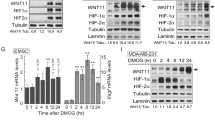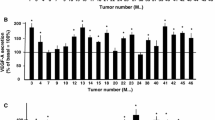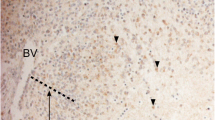Summary
Hypoxia inducible factors (HIF) are transcription factors regulating expression of several genes related to oxygen homeostasis in response to hypoxic stress. Although HIF1-α and platelet derived growth factor-B (PDGF-B) are expressed in glioma tissue and closely related to tumor angiogenesis mediating vascular endothelial growth factor (VEGF) activity, their direct relationship has not yet been clarified. The aim of this study is to investigate whether HIF1-α regulates PDGF-B expression. The human glioblastoma cell lines, U87MG, U251MG, and A172, were exposed to 1–21% oxygen for 24 h. PDGF-B mRNA expression were quantitatively analyzed by real time RT-PCR, their intracellular protein levels were determined by computerized image analysis supported by flow cytometry to detect intracellular PDGF-B, and the concentration of secreted PDGF-B protein was assayed by ELIA. We also assayed following transfection of the cells with short interference RNA (siRNA) targeting HIF1-α mRNA. Relative PDGF-B mRNA and secretion of PDGF-B protein were significantly elevated at 1% oxygen. Following transfection of HIF1-α siRNA at 1% oxygen, PDGF-B expression was significantly suppressed at mRNA level. Our findings indicated that HIF1-α up-regulated expression of PDGF-B in human glioblastoma cells and showed the feasibility of siRNA technology in glioblastoma cell lines.
Similar content being viewed by others
References
Marti HH: Angiogenesis–a self-adapting principle in hypoxia. Exs 163–180, 2005
C Brahimi-Horn J Pouyssegur (2005) ArticleTitleWhen hypoxia signalling meets the ubiquitin-proteasomal pathway, new targets for cancer therapy Crit Rev Oncol Hematol 53 115–123 Occurrence Handle15661562 Occurrence Handle10.1016/j.critrevonc.2004.09.003
D Zagzag DR Friedlander B Margolis M Grumet GL Semenza H Zhong JW Simons J Holash SJ Wiegand GD Yancopoulos (2000) ArticleTitleMolecular events implicated in brain tumor angiogenesis and invasion Pediatr Neurosurg 33 49–55 Occurrence Handle11025423 Occurrence Handle10.1159/000028975 Occurrence Handle1:STN:280:DC%2BD3M%2FotFWjtA%3D%3D
M Albertoni PH Shaw M Nozaki S Godard M Tenan MF Hamou DW Fairlie SN Breit VM Paralkar N Tribolet Particlede EG Van Meir ME Hegi (2002) ArticleTitleAnoxia induces macrophage inhibitory cytokine-1 (MIC-1) in glioblastoma cells independently of p53 and HIF-1 Oncogene 21 4212–4219 Occurrence Handle12082608 Occurrence Handle10.1038/sj.onc.1205610 Occurrence Handle1:CAS:528:DC%2BD38XkslKmtb4%3D
DJ Brat TB Mapstone (2003) ArticleTitleMalignant glioma physiology: cellular response to hypoxia and its role in tumor progression Ann Intern Med 138 659–668 Occurrence Handle12693889
A Damert M Machein G Breier MQ Fujita D Hanahan W Risau KH Plate (1997) ArticleTitleUp-regulation of vascular endothelial growth factor expression in a rat glioma is conferred by two distinct hypoxia-driven mechanisms Cancer Res 57 3860–3864 Occurrence Handle9288800 Occurrence Handle1:CAS:528:DyaK2sXlvFentbo%3D
MA Dery MD Michaud DE Richard (2005) ArticleTitleHypoxia-inducible factor 1: regulation by hypoxic and non-hypoxic activators Int J Biochem Cell Biol 37 535–540 Occurrence Handle15618010 Occurrence Handle10.1016/j.biocel.2004.08.012 Occurrence Handle1:CAS:528:DC%2BD2cXhtFGiu7rP
JS Jurgensen C Rosenberger MS Wiesener C Warnecke JH Horstrup M Grafe S Philipp W Griethe PH Maxwell U Frei S Bachmann R Willenbrock KU Eckardt (2004) ArticleTitlePersistent induction of HIF-1alpha and −2alpha in cardiomyocytes and stromal cells of ischemic myocardium Faseb J 18 1415–1417 Occurrence Handle15247145
S Khatua KM Peterson KM Brown C Lawlor MR Santi B LaFleur D Dressman DA Stephan TJ MacDonald (2003) ArticleTitleOverexpression of the EGFR/FKBP12/HIF-2alpha pathway identified in childhood astrocytomas by angiogenesis gene profiling Cancer Res 63 1865–1870 Occurrence Handle12702575 Occurrence Handle1:CAS:528:DC%2BD3sXivFynsL8%3D
H Kimura A Weisz Y Kurashima K Hashimoto T Ogura F D’Acquisto R Addeo M Makuuchi H Esumi (2000) ArticleTitleHypoxia response element of the human vascular endothelial growth factor gene mediates transcriptional regulation by nitric oxide: control of hypoxia-inducible factor-1 activity by nitric oxide Blood 95 189–197 Occurrence Handle10607702 Occurrence Handle1:CAS:528:DC%2BD3cXhslKhtg%3D%3D
C Lin R McGough B Aswad JA Block R Terek (2004) ArticleTitleHypoxia induces HIF-1alpha and VEGF expression in chondrosarcoma cells and chondrocytes J Orthop Res 22 1175–1181 Occurrence Handle15475194 Occurrence Handle1:CAS:528:DC%2BD2cXotlCntrY%3D Occurrence Handle10.1016/j.orthres.2004.03.002
EL Lund A Hog MW Olsen LT Hansen SA Engelholm PE Kristjansen (2004) ArticleTitleDifferential regulation of VEGF, HIF1alpha and angiopoietin-1, −2 and −4 by hypoxia and ionizing radiation in human glioblastoma Int J Cancer 108 833–838 Occurrence Handle14712484 Occurrence Handle10.1002/ijc.11662 Occurrence Handle1:CAS:528:DC%2BD2cXht1Cit7g%3D
Preusser M, Wolfsberger S, Haberler C, Breitschopf H, Czech T, Slavc I, Harris AL, Acker T, Budka H, Hainfellner JA: Vascularization and expression of hypoxia-related tissue factors in intracranial ependymoma and their impact on patient survival. Acta Neuropathol (Berl) 2004
ML Turcotte M Parliament A Franko J Allalunis-Turner (2002) ArticleTitleVariation in mitochondrial function in hypoxia-sensitive and hypoxia-tolerant human glioma cells Br J Cancer 86 619–624 Occurrence Handle11870546 Occurrence Handle10.1038/sj.bjc.6600087 Occurrence Handle1:CAS:528:DC%2BD38XislCmt7g%3D
D Zagzag M Nomura DR Friedlander CY Blanco JP Gagner N Nomura EW Newcomb (2003) ArticleTitleGeldanamycin inhibits migration of glioma cells in vitro: a potential role for hypoxia-inducible factor (HIF-1alpha) in glioma cell invasion J Cell Physiol 196 394–402 Occurrence Handle12811834 Occurrence Handle10.1002/jcp.10306 Occurrence Handle1:CAS:528:DC%2BD3sXltlSmtrY%3D
R Bos PJ Diest Particlevan JS Jong Particlede P Groep Particlevan der P Valk Particlevan der E Wall Particlevan der (2005) ArticleTitleHypoxia-inducible factor-1alpha is associated with angiogenesis, and expression of bFGF, PDGF-BB, and EGFR in invasive breast cancer Histopathology 46 31–36 Occurrence Handle15656883 Occurrence Handle10.1111/j.1365-2559.2005.02045.x Occurrence Handle1:STN:280:DC%2BD2M%2FjtVanug%3D%3D
MA Friese J Wischhusen W Wick M Weiler G Eisele A Steinle M Weller (2004) ArticleTitleRNA interference targeting transforming growth factor-beta enhances NKG2D-mediated antiglioma immune response, inhibits glioma cell migration and invasiveness, and abrogates tumorigenicity in vivo Cancer Res 64 7596–7603 Occurrence Handle15492287 Occurrence Handle10.1158/0008-5472.CAN-04-1627 Occurrence Handle1:CAS:528:DC%2BD2cXosFynu7Y%3D
N Maeda T Kawamura H Hoshino N Yamada J Blackard S Kushida N Miyano-Kurosaki N Yamamoto K Makino T Yokota K Uchida M Miwa (1998) ArticleTitleInhibition of human T-cell leukemia virus type 1 replication by antisense env oligodeoxynucleotide Biochem Biophys Res Commun 243 109–112 Occurrence Handle9473488 Occurrence Handle10.1006/bbrc.1997.8039 Occurrence Handle1:CAS:528:DyaK1cXpsVWrtA%3D%3D
M Rubenstein R Glick T Lichtor Y Mirochnik P Chou P Guinan (2001) ArticleTitleTreatment of the T98G glioblastoma cell line with antisense oligonucleotides directed toward mRNA encoding transforming growth factor-alpha and the epidermal growth factor receptor Med Oncol 18 121–130 Occurrence Handle11778757 Occurrence Handle1:CAS:528:DC%2BD3MXptVCjtbo%3D Occurrence Handle10.1385/MO:18:2:121
MJ Li JJ Rossi (2005) ArticleTitleLentiviral vector delivery of recombinant small interfering RNA expression cassettes Methods Enzymol 392 218–226 Occurrence Handle15644184 Occurrence Handle1:CAS:528:DC%2BD2MXksFGntrw%3D Occurrence Handle10.1016/S0076-6879(04)92013-7
M Sano Y Kato H Akashi M Miyagishi K Taira (2005) ArticleTitleNovel methods for expressing RNA interference in human cells Methods Enzymol 392 97–112 Occurrence Handle15644177 Occurrence Handle1:CAS:528:DC%2BD2MXksFGnsbs%3D Occurrence Handle10.1016/S0076-6879(04)92006-X
Y Le P Iribarren Y Zhou W Gong J Hu X Zhang JM Wang (2004) ArticleTitleSilencing the formylpeptide receptor FPR by short-interfering RNA Mol Pharmacol 66 1022–1028 Occurrence Handle15258259 Occurrence Handle10.1124/mol.104.001982 Occurrence Handle1:CAS:528:DC%2BD2cXotlGmur8%3D
Zhang L, Yang N, Liang S, Barchetti A, Vezzani C, Huang J, O’Brien-Jenkins A, Rubin SC, Coukos G: RNA Interference: a potential strategy for isoform-specific phosphatidylinositol 3-kinase targeted therapy in Ovarian Cancer. Cancer Biol Ther 3: 2004
CL Dalgard H Lu A Mohyeldin A Verma (2004) ArticleTitleEndogenous 2-oxoacids differentially regulate expression of oxygen sensors Biochem J 380 419–424 Occurrence Handle14984367 Occurrence Handle10.1042/BJ20031647 Occurrence Handle1:CAS:528:DC%2BD2cXksFyiu7o%3D
K Datta J Li SA Karumanchi E Wang E Rondeau D Mukhopadhyay (2004) ArticleTitleRegulation of vascular permeability factor/vascular endothelial growth factor (VPF/VEGF-A) expression in podocytes Kidney Int 66 1471–1478 Occurrence Handle15458440 Occurrence Handle10.1111/j.1523-1755.2004.00910.x Occurrence Handle1:CAS:528:DC%2BD2cXpsVShur4%3D
JM Gleadle BL Ebert JD Firth PJ Ratcliffe (1995) ArticleTitleRegulation of angiogenic growth factor expression by hypoxia, transition metals, and chelating agents Am J Physiol 268 C1362–1368 Occurrence Handle7541940 Occurrence Handle1:CAS:528:DyaK2MXmvVGltbY%3D
A Mayer A Wree M Hockel C Leo H Pilch P Vaupel (2004) ArticleTitleLack of correlation between expression of HIF-1alpha protein and oxygenation status in identical tissue areas of squamous cell carcinomas of the uterine cervix Cancer Res 64 5876–5881 Occurrence Handle15313932 Occurrence Handle10.1158/0008-5472.CAN-03-3566 Occurrence Handle1:CAS:528:DC%2BD2cXmslaks7k%3D
BJ Murphy (2004) ArticleTitleRegulation of malignant progression by the hypoxia-sensitive transcription factors HIF-1alpha and MTF-1 Comp Biochem Physiol B Biochem Mol Biol 139 495–507 Occurrence Handle15544971 Occurrence Handle10.1016/j.cbpc.2004.04.009
WK Cho YR Seong YH Lee MJ Kim KS Hwang J Yoo S Choi CR Jung DS Im (2004) ArticleTitleOncolytic effects of adenovirus mutant capable of replicating in hypoxic and normoxic regions of solid tumor Mol Ther 10 938–949 Occurrence Handle15509511 Occurrence Handle10.1016/j.ymthe.2004.07.023 Occurrence Handle1:CAS:528:DC%2BD2cXpt1WjtLs%3D
R Depping S Hagele KF Wagner RJ Wiesner G Camenisch RH Wenger DM Katschinski (2004) ArticleTitleA dominant-negative isoform of hypoxia-inducible factor-1 alpha specifically expressed in human testis Biol Reprod 71 331–339 Occurrence Handle15031145 Occurrence Handle10.1095/biolreprod.104.027797 Occurrence Handle1:CAS:528:DC%2BD2cXltFKku7c%3D
P Vaupel (2004) ArticleTitleThe role of hypoxia-induced factors in tumor progression Oncologist 9 IssueIDSuppl 5 10–17 Occurrence Handle15591418 Occurrence Handle1:CAS:528:DC%2BD2MXltVWluw%3D%3D Occurrence Handle10.1634/theoncologist.9-90005-10
Tran N L, McDonough WS, Savitch BA, Sawyer TF, Winkles JA, Berens ME: The TWEAK-Fn14 signaling system regulates Glioma cell survival via NFkappa B pathway activation and Bcl-xL/Bcl-w expression. J Biol Chem 2004
E Ulleras A Wilcock SJ Miller GC Franklin (2001) ArticleTitleThe sequential activation and repression of the human PDGF-B gene during chronic hypoxia reveals antagonistic roles for the depletion of oxygen and glucose Growth Factors 19 233–245 Occurrence Handle11811779 Occurrence Handle1:CAS:528:DC%2BD38XivFynt78%3D Occurrence Handle10.3109/08977190109001089
P Guo B Hu W Gu L Xu D Wang HJ Huang WK Cavenee SY Cheng (2003) ArticleTitlePlatelet-derived growth factor-B enhances glioma angiogenesis by stimulating vascular endothelial growth factor expression in tumor endothelia and by promoting pericyte recruitment Am J Pathol 162 1083–1093 Occurrence Handle12651601 Occurrence Handle1:CAS:528:DC%2BD3sXjtVemt7k%3D
AH Shih C Dai X Hu MK Rosenblum JA Koutcher EC Holland (2004) ArticleTitleDose-dependent effects of platelet-derived growth factor-B on glial tumorigenesis Cancer Res 64 4783–4789 Occurrence Handle15256447 Occurrence Handle10.1158/0008-5472.CAN-03-3831 Occurrence Handle1:CAS:528:DC%2BD2cXls1Omsb4%3D
M Enge U Wilhelmsson A Abramsson J Stakeberg R Kuhn C Betsholtz M Pekny (2003) ArticleTitleNeuron-specific ablation of PDGF-B is compatible with normal central nervous system development and astroglial response to injury Neurochem Res 28 271–279 Occurrence Handle12608700 Occurrence Handle10.1023/A:1022421001288 Occurrence Handle1:CAS:528:DC%2BD3sXhtVemsL4%3D
O Potapova H Fakhrai D Mercola (1996) ArticleTitleGrowth factor PDGF-B/v-sis confers a tumorigenic phenotype to human tumor cells bearing PDGF receptors but not to cells devoid of receptors: evidence for an autocrine, but not a paracrine, mechanism Int J Cancer 66 669–677 Occurrence Handle8647631 Occurrence Handle10.1002/(SICI)1097-0215(19960529)66:5<669::AID-IJC15>3.0.CO;2-# Occurrence Handle1:CAS:528:DyaK28XktFynurY%3D
Vordermark D, In regard to DAI et al.: Inhibition of hypoxia inducible factor 1alpha causes oxygen-independent cytotoxicity and induces p53 independent apoptosis in glioblastoma cells. Int J Radiat Oncol Biol Phys 55: 1027–1036; 57: 1196, 2003
DR Collingridge JM Piepmeier S Rockwell JP Knisely (1999) ArticleTitlePolarographic measurements of oxygen tension in human glioma and surrounding peritumoural brain tissue Radiother Oncol 53 127–131 Occurrence Handle10665789 Occurrence Handle10.1016/S0167-8140(99)00121-8 Occurrence Handle1:STN:280:DC%2BD3c7islGmtw%3D%3D
Author information
Authors and Affiliations
Corresponding author
Rights and permissions
About this article
Cite this article
Yoshida, D., Kim, K., Noha, M. et al. Hypoxia Inducible Factor 1-α Regulates of Platelet Derived Growth Factor-B in Human Glioblastoma Cells. J Neurooncol 76, 13–21 (2006). https://doi.org/10.1007/s11060-005-3279-0
Received:
Accepted:
Published:
Issue Date:
DOI: https://doi.org/10.1007/s11060-005-3279-0




